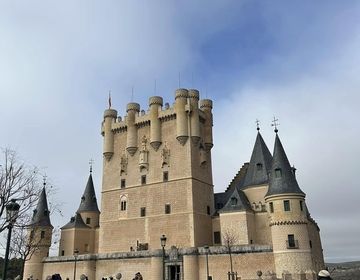A Typical School-Day
“Adonica! Adonica! cómo se dice…” A sandy haired boy in the back of the class strains to put his hand up as high as he can. I hurry to his aid, only to hear the same phrase called from two more students in the front of the class. It feels like I hear this phrase a hundred times a day, but I don’t mind in the least. Before arriving in Spain, we learned that Spanish teachers tend to be very traditional, which means that they stick to the curriculum and use lectures and book-learning. I’m sure many teachers in Spain are traditional, but mine certainly isn’t. Instead, he uses a “flipped classroom” model in which students learn the material on their own and are then evaluated to ensure that they are indeed learning. If this doesn’t make the classroom feel chaotic enough, they are also learning core material in English- a language that they obviously have yet to master.
Sound crazy? It feels a little crazy, but I love the energy of this specific learning model. It’s never boring. The students are always engaged, always asking questions, and you can tell that their minds are working at a hundred miles per minute. It’s fabulous and frenzied, but I believe it works. The students have a very solid beginner/ intermediate level of English and seem to grasp subject specific material (albeit with assistance), as well.
Consequently, I couldn’t be happier with my placement. I admire my host teacher’s energy and creativity, which he maintains even while teaching every age group in the school (from Pre-k to 6th grade), as well as almost every subject from math and science to English and social sciences. It’s truly impressive to watch. Furthermore, if you read my last post, you know that my host school is incredibly small and that teachers in this school juggle several grades in each classroom. For instance, 1st, 2nd, and 3rd grade are all together in one class, while 4th, 5th, and 6th are all together in another class. I thought that perhaps this was a rarity, but it’s not. Many rural communities in Spain combine all ages in the same classroom in a one-room-school house manner. In fact, on Fridays, I travel to two even smaller towns to teach in an elementary school with only 6 students and another with only 20 students. In Abejar, the smallest school, the ages range from 4 to 11 years old.
Can you imagine not only teaching several subjects and grade levels at the same time, but also teaching them all in the same classroom? It’s a lot of work and lesson-planning. Teachers need strong classroom management skills because each age group is working on separate projects and topics simultaneously.
My Role
But enough with my descriptions. You want to know what my role is in all of this. Well, I do a mixture of things. I work with all age groups from Pre-school to 6th grade and am in almost every subject that an elementary school can offer. These subjects include: science, social science, English, math, physical education, and even a journalism class. I have the most freedom in English, for which I prepare cultural presentations, games, discussions, and other activities. I don’t plan as many activities for the other subjects, as the students have a lot of material to cover and need all the time they can get to learn. As a result, I often either work with small groups of students separately, or float around the classroom offering my assistance. Usually, this assistance is composed of exaggerated gestures and long verbal descriptions in which I attempt to help students understand vocabulary and key concepts without speaking Spanish. Basically, these classes always feel like long word guessing games, like charades or taboo, on a regular basis.
My Schedule
Another important question is: what’s my schedule like? Fortunately, my schedule and travel are straightforward. My main school is a 5-minute walk from my hosts’ home and other teachers give me rides to the near-by towns on Fridays. I have about 12 hours of required volunteer work per week, but also attend a workshop on Tuesdays and give private English lessons (for which I am paid) for another hour and a half on Wednesdays. Besides that, the school provides me with 3 hours of Spanish classes per week. As a result, I’m at the school for about 17 and a half hours per week and spend probably about the equivalent of one full day planning activities and presentations each week. Between working at the school, making friends with locals, and spending time with my host family and their many relatives, I am definitely busy!
Is It Worth It?
But the most important question is: is it worth it? My answer is… YES! The kids here are so smart, affectionate, and downright adorable that it’s hard to have a bad day in the school. I am always smiling! And I absolutely love watching them learn. Their energy and excitement are so infectious that it makes working with them one of my favorite parts of being here. Even with limited teaching experience, I am already in love with the classroom.
Related Posts
Visiting Paris for the first time? Here’s what to expect
Advice for first time visitors to Paris plus debunking a few stereotypes!
Staying in a Hostel for the First Time - Sevilla Weekend
I’m not sure where my image of hostels came from. I imagined a space that was dirty, crowded, and unsafe. I’m not sure why it has taken me so long... keep reading


